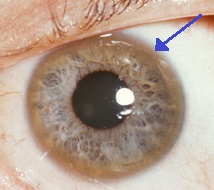Wilson's Disease
| Wilson's disease | |
|---|---|
| Wilson disease, hepatolenticular degeneration | |

A brown ring on the edge of the cornea (Kayser–Fleischer ring) is common in Wilson's disease, especially when neurological symptoms are present
|
|
| Symptoms | swelling of the legs, yellowish skin, personality changes |
| Usual onset | age 5 to 35 |
| Causes | genetic |
| Differential diagnosis | chronic liver disease, Parkinson's disease, multiple sclerosis, others |
| Treatment | dietary changes, chelating agents, zinc supplements, liver transplant |
| Frequency | ~1 per 30,000 |
| Classification | |
|---|---|
| External resources |
Wilson's disease is a genetic disorder in which copper builds up in the body. Symptoms are typically related to the brain and liver. Liver related symptoms include vomiting, weakness, fluid build up in the abdomen, swelling of the legs, yellowish skin, and itchiness. Brain related symptoms include tremors, muscle stiffness, trouble speaking, personality changes, anxiety, and seeing or hearing things that others do not.
Wilson's disease is an autosomal recessive condition due to a mutation in the Wilson disease protein (ATP7B) gene. For a person to be affected they must inherit an affected copy of the gene from each parent. Diagnosis may be difficult and often involves a combination of blood tests, urine tests, and a liver biopsy. Genetic testing may be used to screen family members of those affected.
Wilson's disease is typically treated with dietary changes and medication. Dietary changes involve eating a low copper diet and not using copper cookware. Medications used include chelating agents such as trientine and d-penicillamine and zinc supplements. Complications of Wilson's disease can include liver failure, liver cancer, and kidney problems. A liver transplant may be helpful in those in whom other treatments are not effective or if liver failure occurs.
...
Wikipedia
